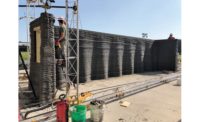Material Researchers 'Painting' in 3D at Northwestern Lab

The nascent 3D-printing industry is working toward the goal of printing large-scale structures with specially designed feed material, but researchers working at a smaller scale are currently exploring techniques for printing a wide range of materials in complex shapes.
PHOTO: ADAM JAKUS, SHAH TEAM LAB, NORTHWEST UNIV.
The nascent 3D-printing industry is working toward the goal of printing large-scale structures with specially designed feed material, but researchers working at a smaller scale are currently exploring techniques for printing a wide range of materials in complex shapes.
Working in the Shah Tissue Engineering and Additive Manufacturing (TEAM) Lab at Northwestern University, graduate students have been busy mixing 3D “paints” made of materials ranging from metals to ceramics to organic tissue. “A lot of people are working on hardware and building task-specific printers, but we are trying to use extrusion-based 3D printing with an expanded material palette,” says Ramille N. Shah, an assistant professor at Northwestern University who directs the lab. “It’s like 3D painting: We can create objects with volumality that can be used for different applications and even engineer bone tissue.”
The process uses particle-based inks made of 95% of the print material, whether it’s metal dust, simulated Martian regolith (below left) or organic tissue. The remaining 5% is a polymer additive that dries during curing. All of the inks can be used with the same 3D-printer nozzle and can be printed and cured at room temperature. Shah’s TEAM Lab researchers also are working on printing dissimilar materials together at the same time, offering new opportunities for fabricating complex objects. “Think of it like when a regular 2D printer prints in color—we want to provide that in 3D inks,” Shah says. Some researchers at Northwestern hope to apply this process to print the thin layers of hydrogen fuel cells all at once, fully assembled.
The relatively small objects produced by TEAM Lab’s 3D printer come out as soft, pliable “green bodies” that lack any real structural strength. But the metal and ceramic shapes can be heated in a furnace to sinter them together, cooking off the polymer binder as they solidify. For more design options, metal green bodies can be easily shaped before sintering, according to Shah. “You can roll them, fold them, do origami, then put in the furnace and get the shape you want. Doing this, we can capture a lot more geometries,” she says.
Related Article: 3D Printing Buildings on Mars Has Lessons for Back on Earth




